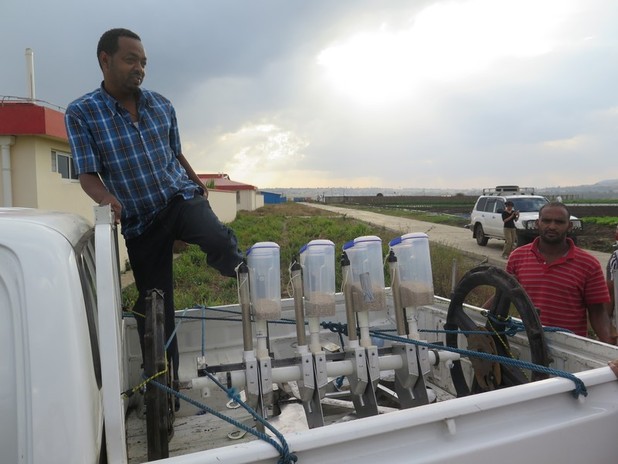April 22, 2014
Martin Schnitzer tells of his team's second day field testing in Ethiopia and their experience overcoming yet another large obstacle to make a functioning teff planter prototype.
For once being jet-lagged and wide awake at 4:00 am played to our advantage. As Ravi talked about in our previous post, upon arrival to Ethiopia, the fertilizer’s metering mechanism wasn’t performing well and we had to fix it before we heading to the fields. So day two of our trip started early.
The large selection of tools we brought in our suitcases started to come in handy, with the hot glue gun quickly becoming our weapon of choice. Serious changes had to be made to our devise, and our team had to get creative. We weren’t just gluing, but rather building entire parts out of hot glue, effectively transforming our tool into a 3D printer.
By breakfast, things were looking much brighter. It would be the first time for our planter to operate on Ethiopian soil, its “home turf,” and finally our metering was functioning properly.
An hour later we arrived at the test field. It had been irrigated for the last couple of days to mimic planting conditions, and the soil consisted of Vertisol—the stickiest of all the soil types. After assembling the planter, Ravi picked up the handle and started pulling it down the field. The fertilizer units and metering were working great—one obstacle overcome! But suddenly, Ravi’s steps started getting smaller. Watching him was like seeing time slow down.
Barely 50 feet down the field and the wheels had picked up enough mud to make it nearly impossible to move any further. We knew the mud would be challenging but we didn’t think it would render the planter useless so quickly. Deflated, we felt like we were thrown back to the beginning of our challenge. Yet again, we had no functional prototype.
First things first, we began to rework our schedule. We knew that we needed to go back to the shop and prototype new wheels, and we needed to do it quickly. So we returned to the shop in Melkasa, part of an agricultural research center, where we had worked during our first trip to Ethiopia in December. The next couple of days were intense and energetic. Looking back at them, they were some of the most inspiring of the entire project. The guys in the shop were supportive, bringing some great skills and knowledge to our challenge, and helped immensely as we rebuilt the wheels from scratch.
For our new wheels, we tested different widths and a number of variations for spikes. But the critical idea came from Salamon, one of the metal workers. He pulled us aside and said we should try to wrap the wheels in burlap. Burlap? There was no rationale but we were desperate enough to try it. Turns out, the burlap worked incredibly well, outperforming all other prototypes.
Wrapping the wheels in burlap isn’t an idea we could have ever come up with in a brainstorm, and burlap certainly isn’t on any list of new high tech materials. However, using burlap came from keeping an open mind to trying new solutions. It came from talking to people who understand the conditions best and by sharing the excitement of this project with others to gain inspiration from a number of places. That’s what human centered design is about! That’s why I don’t consider my job just a job, but rather a way to fully engage with the world.







